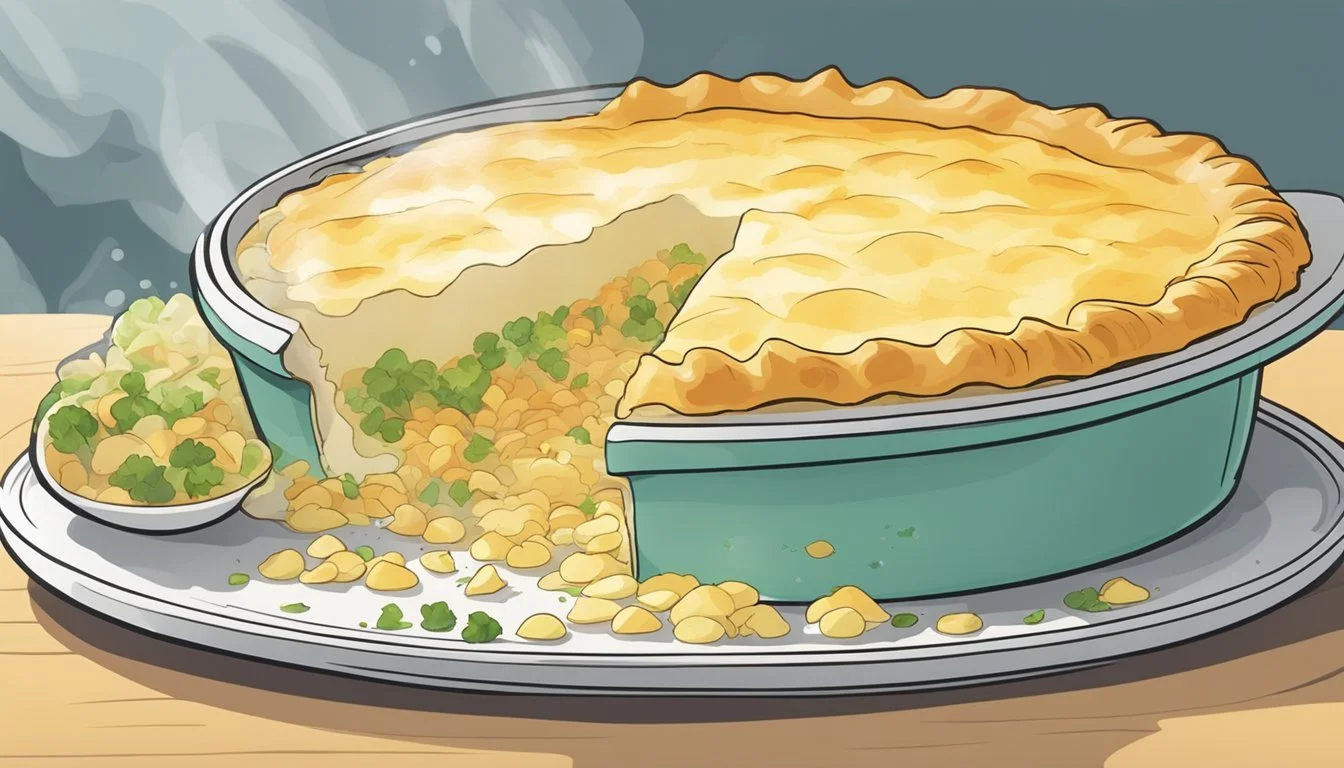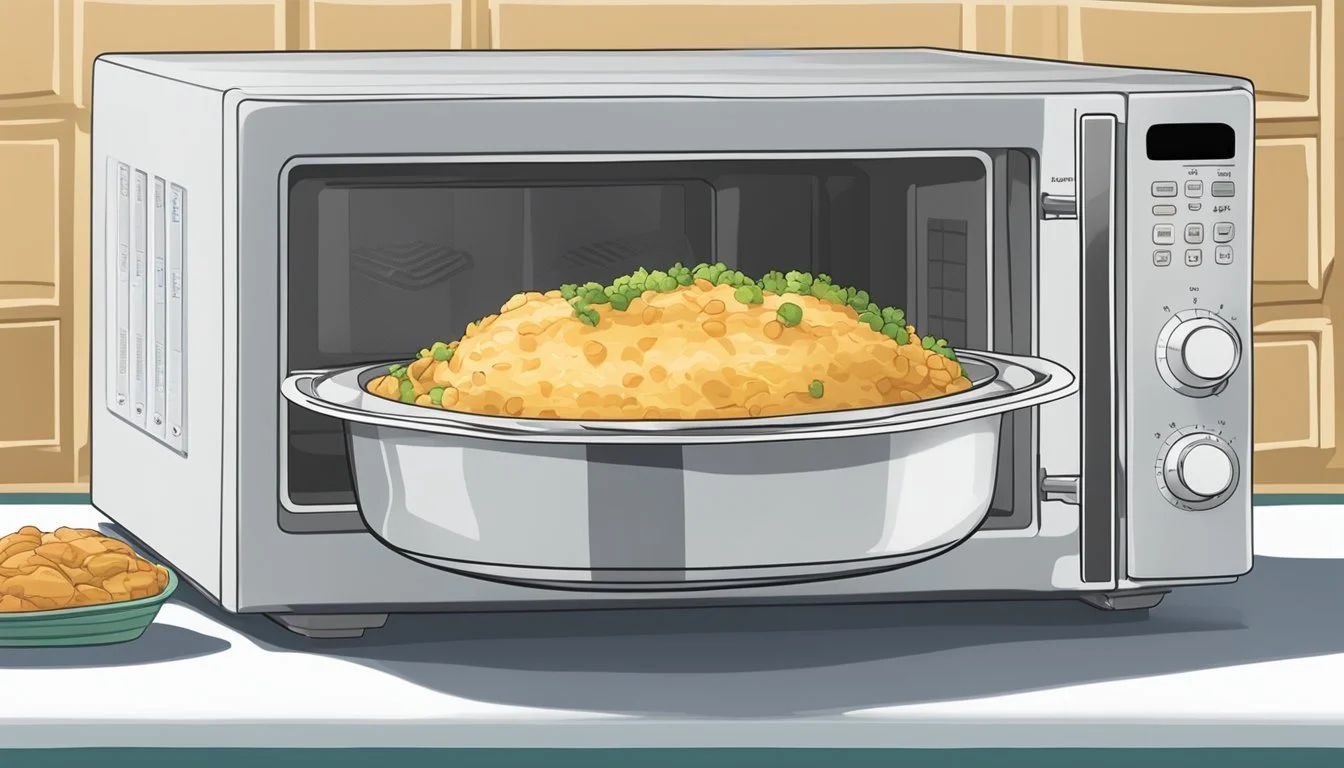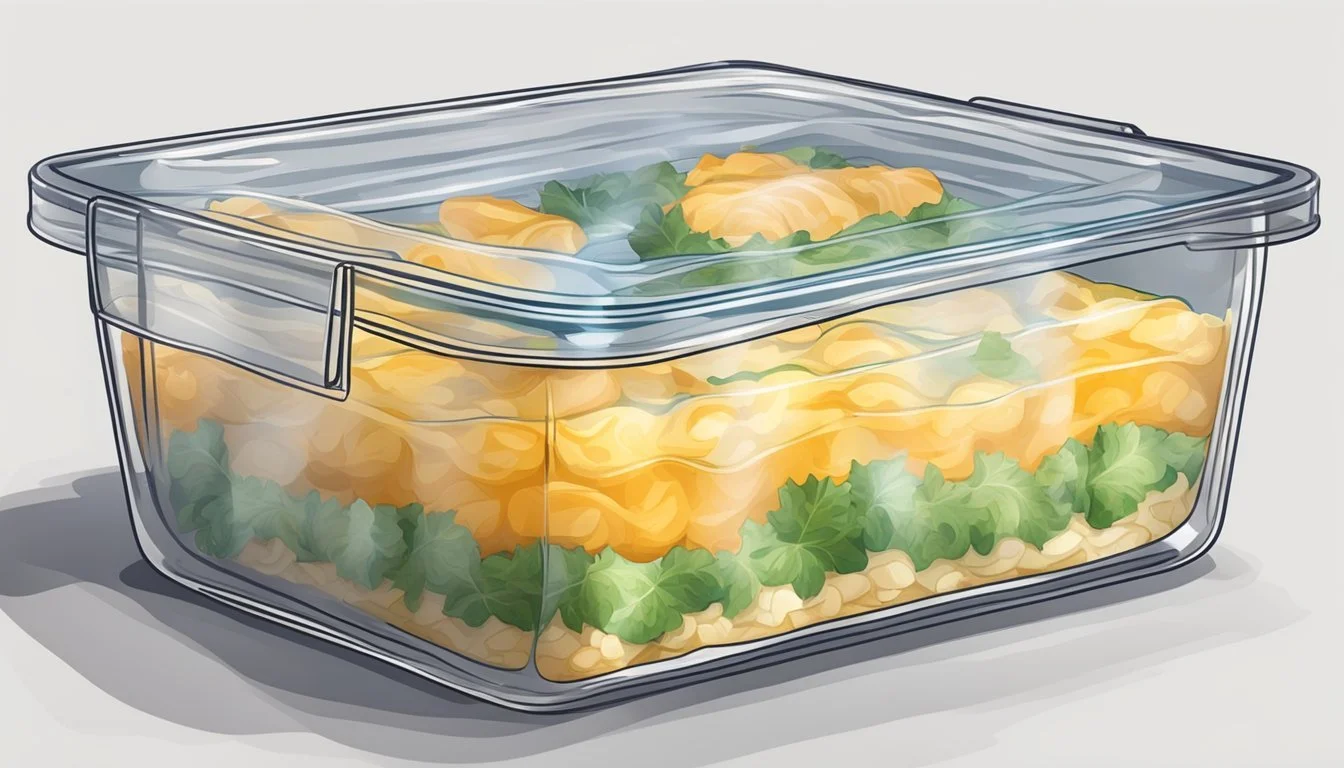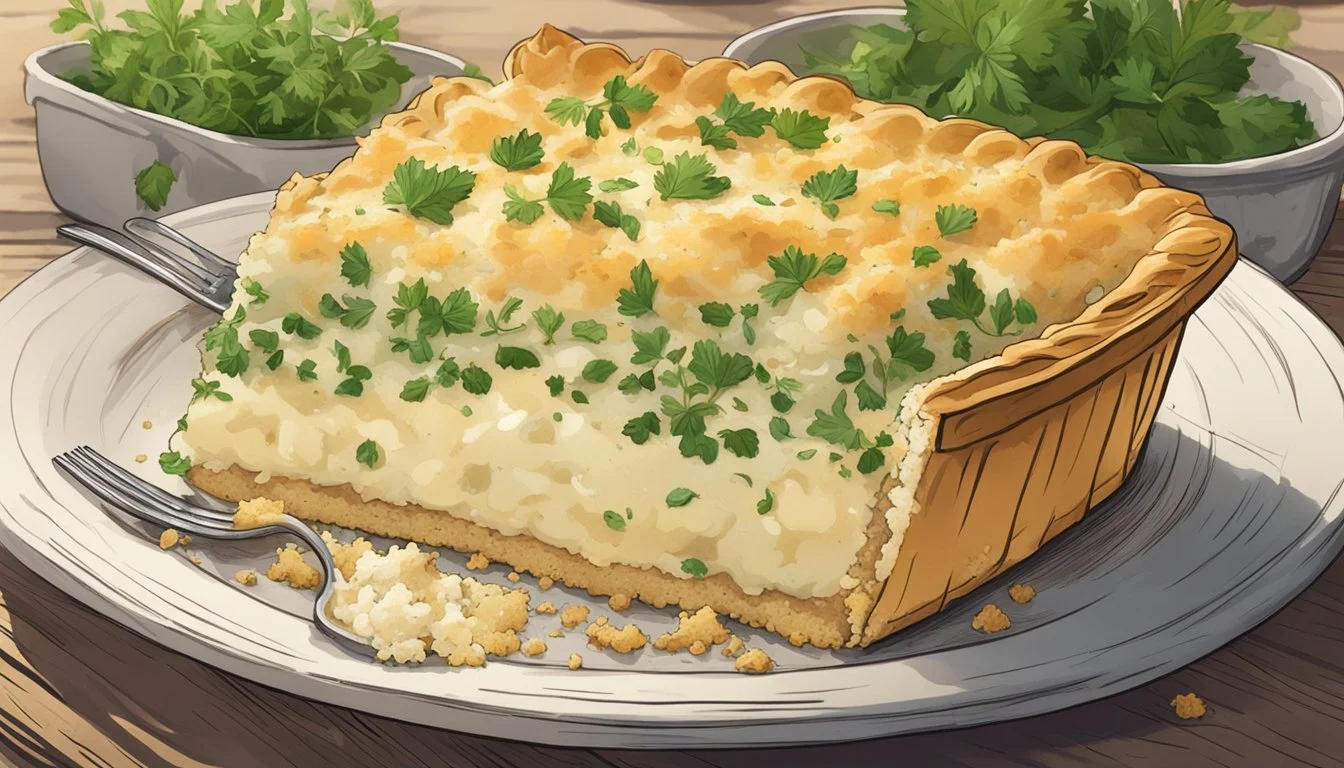How to Reheat Fish Pie
Best Methods for Perfect Results
Reheating a fish pie can seem daunting, but it’s straightforward with the right techniques. The best way to reheat fish pie is in the oven, which helps retain its texture and flavor. Preheat your oven to around 350°F (175°C), cover the pie with aluminum foil to prevent it from drying out, and bake for approximately 20 to 30 minutes.
For smaller portions, 10 to 15 minutes should suffice. Alternatively, if time is of the essence, the microwave presents a quicker, albeit less ideal, option. Place the fish pie in a microwave-safe dish, heat on high for 3-4 minutes, and stir halfway through to ensure even heating.
Reheating leftover fish pie correctly ensures you enjoy a meal that tastes almost as good as it did when freshly made. Properly reheating can transform a weekday lunch or dinner into a comforting and delicious experience.
Fundamentals of Reheating Fish Pie
To reheat fish pie effectively, it is crucial to maintain its texture and flavor. This involves selecting the right reheating method and understanding the essential steps for each approach.
Understand the Basics of Reheating
When reheating fish pie, ensure that it is heated evenly to avoid cold spots, which can occur especially in the microwave. The internal temperature should reach at least 75°C (165°F) to ensure it is safe to eat.
Preheating is essential for ovens, requiring the oven to reach the desired temperature before placing the pie inside. This helps in achieving consistent heat distribution. Wrapping the pie in aluminum foil can prevent the top from over-browning while ensuring that the steam escapes, retaining moisture.
Choosing the Right Reheating Method
Choosing between the oven and the microwave depends on the time you have and the quality you desire.
Oven: Preheat to around 175-180°C (350°F). Place the pie on the middle rack, loosely covered with aluminum foil. For a slice, reheat for about 20 minutes; a whole pie can take 30-40 minutes. The oven maintains the pie's texture, giving a crisp top and moist interior.
Microwave: While faster, it may affect the texture, making the crust less crisp. For best results, heat on high for 2-4 minutes for a slice, checking halfway to ensure even heating. Be cautious of overheating to avoid drying out the fish.
Each method has its benefits but balancing time and the desired quality of the reheated fish pie is key to a satisfying meal.
Preparatory Steps Before Reheating
Proper preparation is essential to reheat a fish pie effectively. This involves either thawing a frozen pie or bringing a chilled pie to room temperature to ensure even heating.
Thawing Frozen Fish Pie
Thawing a frozen fish pie correctly is crucial for even cooking. Begin by removing the frozen pie from the freezer and placing it in the refrigerator. It should remain in the refrigerator for several hours, ideally overnight.
If time is limited, use the defrost setting on your microwave. Place the pie in a microwave-safe dish and select defrost, checking at intervals to avoid partial cooking. Remember that defrost times will vary based on your microwave's power.
Ensure that the pie is fully thawed before reheating in the oven. This helps prevent cold spots and ensures that the center of the pie reaches the desired temperature.
Bringing Chilled Pie to Room Temperature
For a chilled fish pie, allowing it to come to room temperature is recommended. Remove the pie from the refrigerator about 30 minutes to an hour before reheating. This step helps reduce the gap in temperatures, leading to more even reheating.
Cover the pie loosely with aluminum foil to prevent drying out. Letting the pie sit at room temperature ensures that the reheating process is consistent from the outside to the center.
By following these preparatory steps, you ensure that the reheating process is effective and the fish pie is deliciously warm throughout.
Microwave Reheating Technique
Reheating fish pie in the microwave is efficient and convenient, making it a good option for quick meals. Follow the steps below for optimal results and even heating.
Setting Up for Microwave Reheating
When reheating fish pie in the microwave, use a microwave-safe container. This ensures that your dish won't crack or release harmful chemicals.
Covering the pie is important to retain moisture. Use a microwave-safe cover or a lightly dampened paper towel. This prevents drying out and promotes even heating.
Adjust the microwave wattage based on your specific model. Most microwaves have settings between 700 to 1200 watts. Lower wattages require slightly longer reheating times to achieve consistent heat throughout the pie.
Microwave Reheating Steps
Prepare the Fish Pie: Place the leftover fish pie on a microwave-safe plate. Ensure the slice is spread out for even heating.
Cover the Pie: Use a microwave-safe cover or lightly dampen a paper towel and place it over the plate. This traps steam and keeps the pie moist.
Set the Microwave: Adjust the microwave to the appropriate wattage. If your microwave is 1000 watts, set it to reheat for about 2-3 minutes. For lower wattages, extend reheating time in 30-second increments.
Turn and Check: At the halfway point, turn the pie to ensure even heating. After the initial setting, check if it's heated thoroughly. If not, reheat in 30-60 second intervals until done.
Serve Immediately: Once heated through, remove the pie carefully, as the container may be hot. Enjoy your reheated fish pie while it's still warm.
Oven Reheating Strategy
Reheating fish pie in the oven ensures it is heated thoroughly while preserving its texture and flavor. Key points include preheating the oven, using the right baking tools, and following specific steps to avoid overcooking or drying out the dish.
Preheating the Oven
Begin by preheating the oven to 350°F (175°C). Consistent temperature is crucial to evenly reheat the fish pie. Ensuring the oven is properly preheated before placing the dish inside helps maintain its quality.
Allow the oven to reach the desired temperature, which usually takes around 10-15 minutes.
Steps for Oven Reheating
1. Preparation:
Cut a portion-sized slice of the fish pie if it’s a leftover batch.
Place the slice or whole pie in an oven-safe dish.
2. Covering:
Cover the dish loosely with aluminium foil. This prevents excessive browning and keeps the moisture intact.
3. Baking:
Place the baking dish on the middle rack for even heat distribution.
Bake for 20-30 minutes for slices or 30-40 minutes for a whole pie.
4. Final Touch:
Check the internal temperature; it should be at least 165°F (75°C).
Optionally, remove the foil for the last few minutes to crisp up the top.
Alternative Methods and Considerations
When reheating fish pie, there are additional methods beyond the conventional oven and microwave, including the use of a toaster oven, grill, or stovetop.
Using a Toaster Oven or Grill
A toaster oven offers a quick and convenient way to reheat fish pie. Preheat the toaster oven to 350°F (175°C). Place a slice of fish pie in an oven-safe dish. Cover it loosely with foil to prevent the top from burning while allowing steam to escape. Heat for 15-20 minutes or until heated through, removing the foil in the last few minutes for a crisp top.
Using a grill can add a unique char and flavor. Preheat the grill on a low setting. Place the fish pie on a grill-safe tray and cover it with foil. Heat for 10-15 minutes, checking every few minutes to avoid burning. If your grill has a broil setting, use it to crisp the top for the last 2-3 minutes.
Stove Top Reheating Tips
Reheating fish pie on the stove requires a bit of care. Use a heavy-bottomed skillet to ensure even heat distribution. Cut the fish pie into portions and place a slice in the skillet. Cover with a lid to maintain moisture and cook on low heat.
Check and stir gently every 5 minutes to ensure even heating. It may take 10-15 minutes to heat through. It’s essential to avoid high heat, which can dry out the pie and cause the fish to lose its texture. This method works best for smaller portions and can be useful if you need to reheat quickly without an oven or microwave.
Best Practices for Preserving Quality
Reheating fish pie requires attention to detail to maintain its delightful texture and flavor. Taking the right steps can help avoid common pitfalls like dryness or a rubbery texture.
Avoiding Overcooking
Overcooking is a significant risk when reheating fish pie. It can lead to a dry interior and a loss of flavor. Preheat the oven to 350°F (175°C) to provide a stable, moderate temperature that prevents overcooking. For individual portions, 20 minutes is typically sufficient, while a whole pie may need 30-40 minutes.
Covering the dish with aluminum foil helps prevent the top from browning too much. In the final 5 minutes, removing the foil can crisp up the potato topping without overcooking the fish inside. Always check that the internal temperature reaches 165°F (75°C) to ensure safety without further cooking the fish.
Maintaining Moisture and Texture
Maintaining the moisture and creamy texture of fish pie is crucial. Adding a small amount of cream or butter to the top before reheating can help retain moisture. This also enhances the overall flavor, providing a rich and creamy finish.
Ensure the fish pie is covered loosely with foil. This prevents steam from escaping entirely, which helps keep the pie moist. Avoid tightly wrapping the pie, as this can result in a soggy texture for the crispy top layer.
To avoid rubbery textures, especially when using a microwave, use low power settings and short intervals. This method helps evenly distribute heat without drying out the fish. Stir gently between intervals to maintain a smooth consistency in the creamy filling.
These steps collectively help preserve the quality and enjoyment of fish pie upon reheating.
Food Safety Considerations
Reheating fish pie involves careful attention to food safety practices to avoid food poisoning. Key considerations include preventing bacterial growth and ensuring the dish reaches the correct internal temperature.
Preventing Food Poisoning
Fish pie must be reheated properly to prevent food poisoning. Always reheat the pie from a refrigerator or freezer, not from room temperature, to minimize bacterial growth.
Use clean utensils and surfaces during preparation to maintain hygiene. Cover the pie with foil while reheating to ensure it heats evenly, which helps avoid cold spots where bacteria can multiply. Reheat only once to reduce the risk of bacterial contamination.
Understanding Safe Internal Temperatures
Ensuring the fish pie reaches a safe internal temperature is essential. The recommended internal temperature for reheated fish pie is at least 165°F (75°C).
Use a food thermometer to check the temperature in various parts of the pie, particularly the center, to ensure even heating. If using a microwave, stir the pie halfway through heating to distribute the heat evenly. Consistently meeting this temperature requirement helps prevent the risk of foodborne illnesses.
Storing Leftover Fish Pie
Proper storage of leftover fish pie ensures it stays fresh and safe to eat. Two effective methods include freezing and refrigeration, each requiring specific techniques for best results.
Effective Freezing Techniques
Freezing leftover fish pie can significantly extend its shelf life. To do this, allow the pie to cool to room temperature. Wrap each portion tightly in plastic wrap. For added protection against freezer burn, place the wrapped portions into a ziplock bag or an airtight container.
Label the container with the date to keep track of storage time. Fish pie can be frozen for up to three months without significant loss of quality. When ready to reheat, it’s best to thaw the pie overnight in the refrigerator to maintain its texture and flavor.
Refrigeration Advice
If planning to consume the leftovers within a few days, refrigeration is a suitable option. Once the fish pie has cooled to room temperature, transfer it to an airtight container to prevent moisture loss and absorption of other fridge odors.
Store the container in the refrigerator and consume the pie within two to three days. Covering the pie with a lid or plastic wrap will help retain moisture. Labeling the container with the date is useful for food safety and helps in tracking freshness.
Effective refrigeration and freezing techniques ensure the leftover fish pie remains appetizing and safe for future enjoyment.
Enhancing Your Reheated Fish Pie
When reheating fish pie, adding complementary sides and creative ideas for leftovers can elevate the meal. Here's how to maximize the deliciousness of your reheated fish pie.
Adding Complementary Sides and Toppings
To make your reheated fish pie more flavorful, consider adding a few sides and toppings.
Vegetables: Steamed or roasted vegetables such as broccoli, peas, or carrots pair well with fish pie. Not only do they add color, but they also provide a nice nutritional balance.
Salad: A crisp salad with greens, cucumber, and a light vinaigrette can refresh your palate and add a contrasting texture.
Cheese sauce: Drizzling a bit of melted cheese sauce over the top of the reheated pie can add richness and taste.
Potatoes: Serve it with mashed or roasted potatoes to create a more filling comfort meal. These sides enhance the creamy texture of the fish pie.
Creative Ideas for Leftover Pie
Transforming leftover fish pie can keep meals exciting.
Fish Pie Patties: Form the leftover fish pie into small patties, coat them in breadcrumbs, and fry until golden. It’s a fun way to enjoy a crispy exterior with a soft, flavorful center.
Fish Pie Stuffed Potatoes: Hollow out baked potatoes and fill them with reheated fish pie. Top with a sprinkle of cheese, and bake until the cheese melts.
Fish Pie Gratin: Layer the leftover pie in a baking dish, add a bit of cheese and some hard-boiled eggs, and bake until the top is bubbly and golden.
These ideas not only reduce waste but also offer delightful variations on a classic dish.
Understanding Fish Pie
Fish pie is a classic British dish with a rich history, utilizing various ingredients like white fish, a savory sauce, and mashed potatoes. This section will explore the essential components of a traditional fish pie and its popular variations.
Components of a Classic Fish Pie
A traditional fish pie typically includes several key ingredients. The base usually consists of white fish such as cod or haddock, often combined with smoked whitefish for added depth of flavor. Some recipes also include prawns to enhance the seafood mix.
The sauce is a vital component, generally made from a cream or cheese sauce, which binds the ingredients together and adds a rich texture. This sauce is often flavored with leeks or onions, and sometimes seasoned with nutmeg or mustard.
Mashed potatoes form the topping of the pie. These are spread over the fish mixture and baked until golden brown. The mash can be made creamy with the addition of butter and cream, and sometimes a sprinkle of cheese is added on top for a crispy finish.
Variations of the Traditional Dish
While the classic fish pie remains popular, there are several variations that incorporate different ingredients and cooking methods. One common variation uses a mix of white fish and shellfish, such as prawns, to add a variety of textures and flavors.
Some versions of the dish may substitute the mashed potatoes with a pastry crust. This adaptation gives the pie a different texture and appearance while maintaining the traditional filling.
Another variation involves using a gluten-free or dairy-free sauce to cater to dietary restrictions. This might include substituting traditional wheat flour with rice flour for thickening, and plant-based milks like almond or oat instead of cream.
These variations allow for creativity while remaining true to the essence of the traditional British fish pie.








